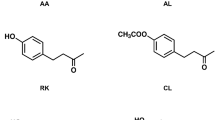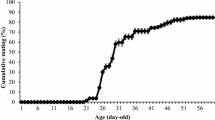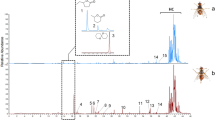Abstract
The guava fruit fly, Bactrocera correcta, is widely distributed in Thailand and other surrounding Southeast Asian countries, and, like the closely related sympatric species, the oriental fruit fly, B. dorsalis, infests various fruits, including guava, peach, and mango. Males of both B. correcta and B. dorsalis are strongly attracted to, and compulsively feed on, methyl eugenol (ME). Bactrocera dorsalis males fed on ME sequester its metabolite phenylpropanoids, (E)-coniferyl alcohol and 2-allyl-4,5-dimethoxyphenol, in the rectal pheromone gland. In contrast, B. correcta males fed on ME sequester two different metabolites, (Z)-coniferyl alcohol (ZCF) and (Z)-3,4-dimethoxycinnamyl alcohol (DMC), in the rectal gland. Examination of the temporal changes of ME metabolites in B. correcta male rectal glands revealed that the total of ZCF and DMC was as high as 100 μg/male at 24 hr after ME feeding. ZCF and DMC were detected in a large proportion of wild B. correcta males captured at various sites in Thailand. Since B. correcta and B. dorsalis are sympatric species in Thailand, these two different subsets of rectal phenylpropanoids could play a role to avoid interbreeding between the species. Further survey of wild flies in Thailand revealed that a large proportion of males of B. correcta store large quantities (over 250 μg/gland) of sesquiterpene hydrocarbons, including β-caryophyllene, α-humulene, and alloaromadendrene in the rectal gland in addition to, or instead of, ZCF and DMC. Laboratory-reared males also sequestered β-caryophyllene and α-humulene, along with ZCF and DMC, when the sesquiterpenes were artificially supplied together with ME. A field test demonstrated that a mixture (1:1) of β-caryophyllene and α-humulene attracted male B. correcta, albeit in smaller numbers than in traps baited with ME. The sequestration of sesquiterpenes, in addition to the different ME metabolites in the pheromone gland in B. correcta males, contrasts with the situation in B. dorsalis males, suggesting a potential role in intra and/or inter-specific interactions between these sympatric species.






Similar content being viewed by others
References
Chyau, C. C, Chen, S. Y., and Wu, C. M. 1992. Differences of volatile and nonvolatile constituents between mature and ripe guava (Psidium guajava Linn) fruits. J. Agric. Food Chem. 40:846–849.
Gonçalves, G. B., Silva, C. E., Santos, J. C. G. dos, Santos, E. S. dos, Nascimento, R. R. do, Silva, E. L. da, and Mendonça, A. de. 2006. Comparison of the volatile components released by calling males of Ceratitis capitata (Diptera: Tephritidae) with those extractable from the salivary glands. Fla. Entomol. 89:375–379.
Hee, A. K. W., and Tan, K. H. 1998. Attraction of female and male Bactrocera papayae to conspecific males fed with methyl eugenol and attraction of females to male sex pheromone components. J. Chem. Ecol. 24:753–764.
Hee, A. K. W., and Tan, K. H. 2006. Transport of methyl eugenol-derived sex pheromonal components in the male fruit fly, Bactrocera dorsalis. Comparative Biochem. Physiol. Part C 143:422–428.
KHOO, C. C. H., YUEN, K. H., and TAN, K. H. 2000. Attraction of female Bactrocera papayae to sex pheromone components with two different release devices. J. Chem. Ecol. 26:2487–2496.
Koyama, J., Teruya, T., and Tanaka, K. 1984. Eradication of the oriental fruit fly (Diptera: Tephritidae) from the Okinawa Islands by a male annihilation method. J. Econ. Entomol. 77:468–472.
Nation, J. L. 1990. Biology of pheromone release by male Caribbean fruit flies, Anastrepha suspensa (Diptera: Tephritidae). J. Chem. Ecol. 16:553–572.
Nishida, R., and Fukami, H. 1990. Sequestration of distasteful compounds by some pharmacophagous insects. J. Chem. Ecol. 16:151–164.
NISHIDA, R., TAN, K. H., LAJIS, N. H., SUKARI, A. M., TAKAHASHI, S., and FUKAMI, H. 1988a. Accumulation of phenylpropanoids in the rectal glands of males of the Oriental fruit fly, Dacus dorsalis. Experientia 44:534–536.
NISHIDA, R., TAN, K. H., and FUKAMI, H. 1988b. cis-3,4-Dimethoxycinnamyl alcohol from the rectal glands of male Oriental fruit fly, Dacus dorsalis. Chem. Exp. 3: 207–210.
Nishimura, O., Yamaguchi, K., Mihara, S., and Shibamoto, T. 1989. Volatile constituents of guava fruits (Psidium guajava L.) and canned puree. J. Agric. Food Chem. 37:139–142.
ORANKANOK, W., CHINVINIJKUL, S., THANAPHUM, S., SITTILOB, P., and ENKERLIN, W. R. 2007. Area-wide integrated control of oriental fruit fly Bactrocera dorsalis and guava fruit fly Bactrocera correcta in Thailand, pp. 517–526, in M. J. B. Vreysen, A. S. Robinson and J. Hendrichs (eds.). Area-Wide Control of Insect Pests. Springer, The Netherlands.
Sandoval, I. S., Hernandez, S. Valdez, G. V., and Cruz-Lopez, L. 2007. Volatiles of mango var. Ataulfo characterized by SPME and capillary GC/MS spectroscopy. J. Mex. Chem. Soc. 51:145–147.
Shelly, T. E., and Dewire, A. 1994. Chemically mediated mating success in male oriental fruit flies, Bactrocera dorsalis (Diptera: Tephritidae). Ann. Entomol. Soc. Am. 87:375–382.
Shivashankara, K. S., Isobe, S., Horita, H., Takenaka, M., and Shiina, T. 2006. Volatile aromatic constituents of tree ripened and mature green ‘Irwin’ mango fruits during low temperature storage. J. Jpn. Soc. Hortic. Sci. 75:209–212.
Soares, F. D., Pereira, T., Marques, M. O. M., and Monteiro, A. R. 2007. Volatile and non-volatile chemical composition of the white guava fruit (Psidium guajava) at different stages of maturity. Food Chem. 100:15–21.
Steiner, L. F., Mitchell, W. C., Harris, E. J., Kozuma, T. T., and Fujimoto, M. S. 1965. Oriental fruit fly eradication by male annihilation. J. Econ. Entomol. 58:961–964.
Tamura, H., Boonbumlung, S., Yoshuzawa, T., and Varanyan, W. 2000. Volatile components of the essential oils in the pulp of four yellow mangoes (Mangifera indica L.) in Thailand food science and technology research. Food Sci. Technol. Res. 6:68–73.
Tan, K. H., and Nishida, R. 1996. Sex pheromone and mating competition after methyl eugenol consumption in the Bactrocera dorsalis complex, pp 147–153, in B. A. McPheron and G. J. Steck (eds.). Fruit Fly Pests–A World Assessment of their Biology and Management. St. Lucid Press, Florida.
Tan, K. H., and Nishida, R. 1998. Ecological significance of male attractant in the defense and mating strategies of the fruit fly Bactrocera papayae. Entomol. Exp. Appl. 89: 155–158.
Tan, K. H., Tan, L. Z., and Nishida, R. 2006. Floral phenylpropanoid cocktail and architecture of Bulbophyllum vinaceum orchid in attracting fruit flies for pollination. J. Chem. Ecol. 32:2429–2441.
Wee, S. L., and Tan, K. H. 2001. Allomonal and hepatotoxic effects following methyl eugenol consumption in Bactrocera papayae male against Gekko monarchus. J. Chem. Ecol. 27:953–964.
Wee, S. L., and Tan, K. H. 2005. Male endogenous pheromonal component of Bactrocera carambolae (Diptera: Tephritidae) deterred gecko predation. Chemoecology 15:199–203.
Acknowledgements
We thank S. Chinvinijkul, Supaap Pinkeaw, and Akkajit Duangkum of the Department of Agricultural Extension, Bangkok, for their assistance during this investigation. We are also grateful to Dr. Todd E. Shelly (USDA-APHIS, Waimanalo, Hawaii, USA) for reviewing this paper. This work was partly supported by the Grant-in-Aid for Scientific Research from JSPS (No. 19310142) from the Ministry of Education, Culture, Sports, Science and Technology of Japan, and JST in Research for Promoting Technological Seeds.
Author information
Authors and Affiliations
Corresponding author
Rights and permissions
About this article
Cite this article
Tokushima, I., Orankanok, W., Tan, K.H. et al. Accumulation of Phenylpropanoid and Sesquiterpenoid Volatiles in Male Rectal Pheromonal Glands of the Guava Fruit Fly, Bactrocera correcta . J Chem Ecol 36, 1327–1334 (2010). https://doi.org/10.1007/s10886-010-9874-3
Received:
Revised:
Accepted:
Published:
Issue Date:
DOI: https://doi.org/10.1007/s10886-010-9874-3




